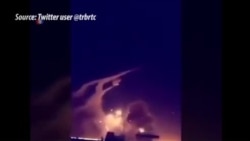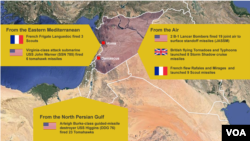Gen.Sergei Rudskoy’s full statement contains multiple inaccurate claims and we will get to them but first the portion that is attracting much of the international interest – that “71 cruise missiles have been intercepted.”
Brian G. Williams, the author of the book “Counter Jihad. The American Military Experience in Afghanistan Iraq and Syria” told Polygraph.info the “claims that 71 of US French and British missiles were intercepted are in the realm of fantasy.”
“Not even the advanced Israeli Iron Dome anti-missile system or U.S. Patriot anti-missile systems could achieve such a success rate,” Williams said.
The expert argues that if Russia’s claims were true, there would have been “deaths on the ground.”
“Tomahawks are massive missiles. If 71 were intercepted there would have been many cases of shrapnel and lethal debris falling on civilian inhabited areas and footage of Tomahawk debris and wreckage. There have not been,” he added.
In the hours after the attack, videos and photos emerged allegedly showing evidence of interceptions and supporting Russia’s claims. However, the Atlantic Council’s Digital Forensic Research Lab (DFRLab) detailed that the instances it found were “in fact recycled from other conflicts.”
The DFRLab points out that its work verifying the location of the airstrikes did not provide independent information on possible interceptions.
Brian Williams said, the evident destruction at the targeted chemical and command facilities in Homs and Damascus “speaks volumes” to the ability of the Americans, French and British to achieve their goals via shooting over 100 missiles, said Williams, some of which would have been “redundant systems” (i.e. calculated to hit the target if other missiles missed it or were intercepted).
The U.S. military’s claims that the Syrian air defenses “had no material effect” on the attack’s objectives appears to be accurate based on the devastation clearly visible in the footage on Syrian TV, Williams said. The evidence leaves, perhaps, only the question of whether Syrian air defenses succeeded in disrupting a few missiles.
On to the other claims in Gen. Rudskoy’s comments:
--The strikes targeted and hit “military and civilian objects”;
--The “announced” participation of France has not been "detected";
--The strikes were under fake pretense after “imaginary” chemical attack;
-- The goal of the operation was to prevent the Organization for Prohibition of Chemical weapons experts in Syria from discovering that there was no chemical attack;
According to the Pentagon, the coordinated attack targeted with precision three Syrian chemical weapons facilities, and, contrary to Rudskoy’s claim, U.S. defense officials say a major part of the planning was specifically designed with the goal to avoiding civilian casualties.
Apart from the Russian media, none of the international observers reported any civilian objects targeted by the U.S.-led strikes. The United Nations Security Council, gathered upon Russia’s request, voted against Russia-proposed resolution condemning the airstrikes.
The British Ambassador to the U.N. Karen Pierce said, the action was “limited” and avoided civilian casualties.
Regarding the claim of France's "undetected" participation in the strikes – the Kremlin’s own Russia Today showed a raw footage of the French air forces taking off for Syria.
The French presidential office released a raw footage of the nation’s Security Council, led by Emmanuel Macron after he ordered an attack on Syrian chemical weapon facilities.
“The operation against the chemical capabilities of the Syrian regime… has achieved its objectives,” the French president said after the attack, praising “the excellent co-ordination of our forces with those of our British and American allies.”
In the week before the coordinated strike, Macron announced France has proof the Syrian government used chemical weapons against civilians.
Apart from the French and the U.S. governments, Rudskoy’s claim regarding the “imaginary” use of chemical weapons by the Syrian regime in Douma, is challenged by multiple independent reports, including the World Health Organization (WHO).
“An estimated 500 patients presented to health facilities exhibiting signs and symptoms consistent with exposure to toxic chemicals,” the WHO statement says.
Polygraph.info previously debunked similar statements claiming that the chemical attack was staged.
As to the final point, that the strikes were conducted to prevent investigators from supporting Russia’s claim of no chemical attack, the location of the targets debunks that claim.
The strikes targeted three specific places and those did not include Douma where the chemical attack took place, and so the claim that the coalition’s attack would prevent the experts of the Organization for Prohibition of Chemical Weapons (OPCW) from conducting an objective investigation does not withstand scrutiny.








